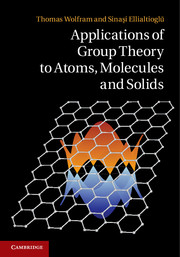Book contents
- Frontmatter
- Contents
- Preface
- 1 Introductory example: Squarene
- 2 Molecular vibrations of isotopically substituted AB2 molecules
- 3 Spherical symmetry and the full rotation group
- 4 Crystal-field theory
- 5 Electron spin and angular momentum
- 6 Molecular electronic structure: The LCAO model
- 7 Electronic states of diatomic molecules
- 8 Transition-metal complexes
- 9 Space groups and crystalline solids
- 10 Application of space-group theory: Energy bands for the perovskite structure
- 11 Applications of space-group theory: Lattice vibration
- 12 Time reversal and magnetic groups
- 13 Graphene
- 14 Carbon nanotubes
- Appendix A Vectors and matrices
- Appendix B Basics of point-group theory
- Appendix C Character tables for point groups
- Appendix D Tensors, vectors, and equivalent electrons
- Appendix E The octahedral group, O and Oh
- Appendix F The tetrahedral group, Td
- Appendix G Identifying point groups
- Index
Appendix A - Vectors and matrices
Published online by Cambridge University Press: 18 December 2013
- Frontmatter
- Contents
- Preface
- 1 Introductory example: Squarene
- 2 Molecular vibrations of isotopically substituted AB2 molecules
- 3 Spherical symmetry and the full rotation group
- 4 Crystal-field theory
- 5 Electron spin and angular momentum
- 6 Molecular electronic structure: The LCAO model
- 7 Electronic states of diatomic molecules
- 8 Transition-metal complexes
- 9 Space groups and crystalline solids
- 10 Application of space-group theory: Energy bands for the perovskite structure
- 11 Applications of space-group theory: Lattice vibration
- 12 Time reversal and magnetic groups
- 13 Graphene
- 14 Carbon nanotubes
- Appendix A Vectors and matrices
- Appendix B Basics of point-group theory
- Appendix C Character tables for point groups
- Appendix D Tensors, vectors, and equivalent electrons
- Appendix E The octahedral group, O and Oh
- Appendix F The tetrahedral group, Td
- Appendix G Identifying point groups
- Index
Summary
Vectors
A vector in n-dimensional space is specified by n components that give the projections of the vector onto the n unit vectors of the space: V = (v1, v2, v3, …, vn). Two vectors are equal if all of the components are equal. The components may be real or complex numbers. Vectors obey the following rules:
(r and s are any real or complex numbers). The inner product or (Hermitian) scalar product of two n-dimensional vectors U and V is
The magnitude, or length, of V is |V| = (V, V)1/2. It is a positive number. It is zero if and only if V = 0, and V = 0 if and only if vi = 0 for all i. A “normalized” vector has |V|= 1.
The scalar product, (U, V)/|V|, is the projection of U onto V, and the cosine of the angle, ø, between two vectors is
If cos ø = 1, U and V are parallel vectors. If cos ø = 0, U and V are orthogonal. The scalar product of two vectors is unchanged if both vectors are subjected to the same symmetry operation. For example, if U and V are subjected to a rotation R or operator PR,
Aset of m normalized, mutually orthogonal, n-dimensional vectors, U1, U2, …, Um, is an orthonormal set.
Information
- Type
- Chapter
- Information
- Applications of Group Theory to Atoms, Molecules, and Solids , pp. 410 - 414Publisher: Cambridge University PressPrint publication year: 2014
